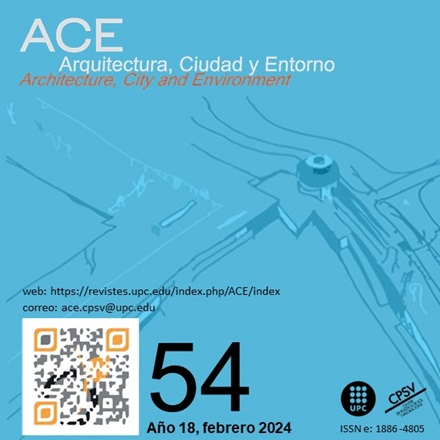El model d’ordenació de la filera única a la ciutat moderna alemanya
DOI:
https://doi.org/10.5821/ace.18.54.11870Paraules clau:
urbanisme alemany, habitatge petit, forma urbana, ZeilenbauResum
En aquest article s’estudien els canvis en l’estructura física que tenen lloc a la ciutat alemanya durant les tres primeres dècades del segle XX i que condueixen, finalment, a una forma d’ordenació característica de l’urbanisme modern alemany: la filera única. Una manera sistemàtica de relacionar l’edificació i l’espai lliure, una nova manera d’ordenar la ciutat a la primera postguerra alemanya que transcendirà un urbanisme de projecció internacional. La investigació es realitza des de l’estudi de fonts primàries del període, cosa que permet un enfocament original que presenta idees menys difoses en la historiografia més general de l’urbanisme alemany, incidint en els moments rellevants per a aquests canvis i les raons que els motiven, i acotant cronològicament aquesta transformació. La tornada al contacte amb l’espai natural, un desig de fort arrelament a la cultura germànica, guia tot el procés. També la conformació d’aquest darrer estadi de la forma urbana es pot entendre com a conseqüència d’aquesta idea. Sobre els factors econòmics, considerats determinants per a la configuració del sistema de filera única, del Zeilenbau, es destaquen els factors intel·lectuals o creatius com a principals impulsors d’una forma urbana que integrada al verd genera la nova percepció paisatgista de la ciutat oberta, la gènesi de la ciutat contemporània.
Descàrregues
Publicades
Número
Secció
Llicència
| CRITERIS DE PROTECCIÓ INTEL·LECTUAL |
En aquest moment es compta amb la protecció de la Oficina Espanyola de Patents i Marques, mentre que la protecció global s'està tramitant davant la Organització Mundial de la Propietat Intel·lectual (OMPI/WIPO). Així mateix, la Oficina del Número de Sèrie Estàndar Internacional (ISSN) ha otorgat els següents números: 1886-4805 (versió electrònica) i 1887-7052 (versió en paper). |
| COPYRIGHT |
El contingut dels articles i els comentaris en ells expresats són responsabilitat exclusiva dels seus actors, i no reflexen necessariament la opinió del Comité Editor de la revista. Els treballs publicats per ACE queden sotmesos a la llicència CC BY-NC-ND 3.0 ES http://creativecommons.org/licenses/by-nc-nd/3.0/es/ La qual cosa vol dir que les persones autores només tenen i retenen els drets d'autor dintre de les limitacions imposades per la anterior llicència |





































